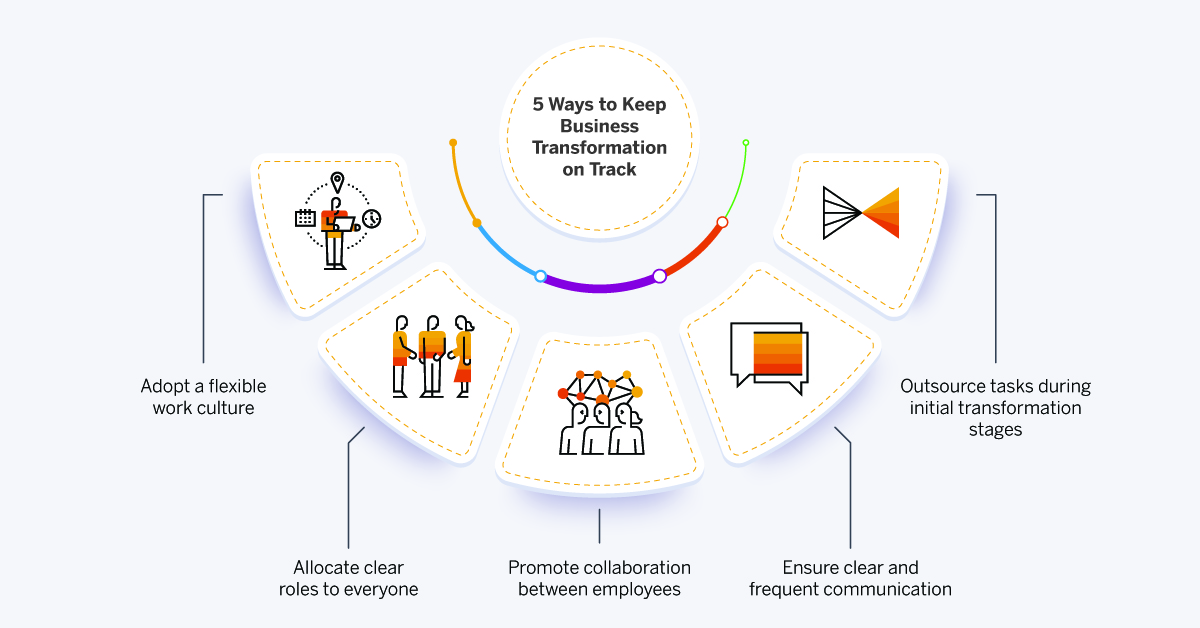With the advent of digitization, innovative technologies, and tech-enabled disruption, the world is shifting to the future at a pace faster than one would have imagined even a few years ago. Businesses, long focused on better returns and cheaper processes as yardsticks of success, now need to reinvent what their company is and does. This is the core of business transformation.
What is business transformation?
The term ‘business transformation’ is the name for a collective set of processes or changes, meant to make the company work more efficiently with changing market dynamics and accelerate its growth in a competitive environment.
Business transformation involves identifying new techniques and processes to increase productivity. Innovative technologies, such as business analytics tools and business management software, can create additional value and make existing processes more efficient. An optimal business transformation is a gradual process that can take years and might require holistic changes in all the aspects of the company.
Types of business transformation
Following are the five different types of business transformation that companies can undertake, either independently or simultaneously:
- Business process transformation
It focuses on processes and changing how these are carried out to streamline actions and save time and resources. One way to do this is by automating low-value, repetitive processes, usually accomplished by digitization. An example is introducing business management software for marketing and sales automation. Business process transformation reduces employee workload and increases the value of the product or service offered by the company.
- Data transformation
By putting information at the center of the innovation and product creation process, data transformation affects the way organizations make decisions. It enables businesses to obtain a comprehensive understanding of all aspects of the customer experience and to identify areas for improvement. Data transformation also involves new methods of collecting data or utilizing existing data in more efficient ways, such as using business analytics tools.
- Organizational transformation
The workforce of a company is its most valuable asset. With organizational transformation, the company assesses how the employees operate, gives them opportunities to work more efficiently, develops their skills, etc. It also includes hiring new members, upskilling existing employees, and encouraging flattened hierarchy.
- Management transformation
It involves decentralizing the decision-making process and weakening rigid hierarchies to encourage two-way communication between managers and employees. Eliminating middlemen in the company and giving the power of self-assessment to employees are other aspects of management transformation.
- Cultural transformation
Arguably one of the hardest to get right, this transformation requires a significant amount of time. It involves changing how a company works, thinks and behaves. From gradually changing the existing work culture convincing all employees to support the desired culture, this process needs a strong vision and a top-down approach.
Five ways to ensure your business transformation goes as planned
As more and more organizations strive to get business transformation right, it has become clear that there is a need for an integrated approach linking organizational culture, business strategy and executive actions. Following are five ways in which a business can derive actual value from transformation:
- Adopt a flexible work culture
Rather than following a rigid organizational culture that does not factor in new systems, a company should strive to make its culture flexible and adaptable. The employees should be given the freedom to experiment, take reasonable risks and learn from their mistakes. Otherwise, fear of censure and errors will prevent them from exploring new tools or adopting new practices. The organization should also be willing to sacrifice traditional or long-standing methods rendered obsolete in the new age. An example is accepting the work-from-home culture in the new normal, otherwise perceived as a not-so-effective model. A flexible work culture helps motivate the employees to actively participate in the process and learn new skills, while adding value to both the company and customer experience.
- Allocate clear roles to everyone
As new processes and procedures are introduced, it is natural that there will be some confusion. A way to counter this is by clearly defining the scope, nature and extent of each employee’s work. This will avoid duplication of work, reduce wastage of effort and also allow employees to quickly pick up and master new tools related to specific tasks.
- Promote collaboration between employees
Encourage business departments to work together and share ideas for company transformation. Cross-departmental collaboration can help a company communicate more effectively and adapt to changes. Both onsite and remote employees should be equal participants in this process. For this, deploying business management software will be effective. Another advantage of departmental collaboration is that departments with prior transformation experience can assist in transforming other departments. Business analytics tools and data can be used to prepare insights for the transformation processes and communication of results.
It can be challenging to get everyone on board before and throughout a business transition. This is especially true for major companies, with offices and branches all over the world. Thus, inter-departmental and enterprise-wide communication must become a top focus.
- Ensure clear and frequent communication
The lack of clarity and knowledge about what digital transformation is and what it means to the firm is a major roadblock. Clear and constant communication helps employees understand where the organization is going, why it is changing, and why the changes are critical.
Communication should also instill a feeling of urgency about the business transformation. This will ensure that employees stay alert and motivated and the transformation process is completed in time.
- Outsource tasks during initial transformation stages
During transformation, employees will be grappling with new processes and newer technology. It might not be possible for them to work at the same pace as before, at least for some time. Penalizing them for the same will lead to anger and resistance to change. One way to handle this is by outsourcing specific tasks, till the time the employees are familiar and comfortable with their roles and functions. This will also ensure business continuity and uninterrupted service to customers, thereby safeguarding the reputation and brand image of the business in the market.

Factors that impact business transformation
Even during times of increased uncertainty, a business transformation is possible if certain factors are taken into consideration and appropriated to suit the end goals. Some of these are:
- Views of top leadership on changes
A business transformation process can either be a lengthy thought-out procedure or the aftereffect of an immediate crisis or shift in the market. In either case, the success of the approach depends significantly on the actions and thought processes of the top leadership. A supportive leadership should acknowledge the efforts made, encourage communication between employees to reduce resistance, and demonstrate the relationship between new initiatives and the organization’s goals.
- Speed of adoption of the business transformation
When it comes to business transformation, the theory of ‘slow and steady wins the race’ might not work all the time. Studies have shown that if the transformation process is too slow, the company will likely fall behind the competition. It can eventually result in a gradual decrease in customer, and even employee, faith in the brand and its products.
- Diversity and inclusion policies
Many companies have started to invest more time and effort in diversity and inclusion practices. With diverse skill sets come fresh perspectives, which lead to innovative and future-proof ideas. It can also infuse energy into the workforce, making them less worried about change.
- Mindset of employees
Employee engagement is a critical component in facilitating change acceptance. Successful transformations have historically had a larger percentage of supportive employees. The crucial step is to alleviate their concerns about the changes and make them aware of the benefits accrued by new technologies. As changes and shifts in market dynamics make new technologies such as business analytics tools necessary, employee buy-in becomes even more essential to leverage the true value of such initiatives.
- Adoption of digital technology
As remote and hybrid working models become popular, companies are increasing their investment in advanced technologies such as business management software to keep their employees connected. Clearly, converged technical architecture with shared governance models helps increase the productivity, efficiency and resilience of an organization.
- Focus on data management and data-driven solutions
Data is critical for establishing the necessary skills, competencies, and change-adaptive culture to sustain the transformation’s value. Gathering, storing and analyzing data is a vital component for any digital-focused business. Leaders also need to leverage data-driven change management solutions that have an analytical approach to make better decisions.
An enterprise-wide business transformation can start by focusing on employee experience, digital capabilities and operational transparency. The aim should be to combine technical expertise with human knowledge, to give rise to a truly adaptive enterprise.



